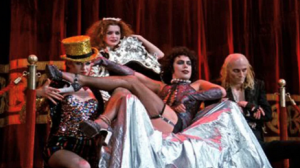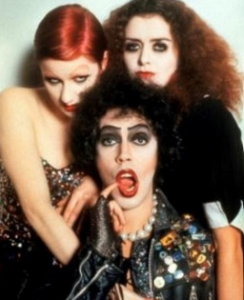7
I want to do the “Time Warp” again!
By Christy Ruse
In the late 1980s and early 90s, when I was in high school, there were many weekends you could find me in the Seattle U-district catching a midnight showing of 20th Century Fox’s 1975 cult classic film, The Rocky Horror Picture Show (“Rocky”) at the Neptune theater. Going to see Rocky was an experience. I had never been to a movie before, or since, where there was so much audience participation. Every show began with a gathering of the “virgins,” those who had never seen Rocky before. As a teenager, I in no way realized there were messages encoded in the media sources I chose for entertainment, and I believe those messages within Rocky had a positive impact on me. It helped cement my open mind and acceptance, primarily as related to sexuality and gender fluidity.
In the 70s, American society was riding the wave of several social movements stemming from race to sexuality. In his bachelor’s diploma thesis, Pavla Šimková argues “although usually perceived as only an oddball midnight movie which can only be appreciated by minority audiences, [Rocky] has been influenced in a substantial way by the 1970s social and cultural phenomena and that it, in turn, reflects these features and becomes in a way a showcase of some of the major social and cultural tendencies of the 1970s, particularly those connected with the counterculture.” (Šimková 40). I wonder if Richard O’Brien had any idea of the phenomenon that the movie based on the musical stage production he wrote in 1973 would become? Could he have foreseen how his parody tribute for B-horror flicks would inspire the embracing of sexual liberation and androgyny?

The LGBTQ+ community was becoming more open, having taken a stand in June of 1969 when a riot broke out after the police raided the Stonewall Inn, a gay bar in New York City. Raids like the one executed at the Stonewall Inn were frequent occurrences at this time, and LGBTQ+ community was regularly targeted. Nine people were arrested at Stonewall for breaking an archaic law that required the “wearing at least three articles of gender-appropriate clothing” (“Stonewall Riots”). However, Hollywood’s narrative of patriarchal heterosexual monogamy continued, as there were strict rules governing the representation of sex and sexuality enforced by the Production Code Administration. In America on Film: Representing Race, Class, Gender, and Sexuality at the Movies, the authors point out that “connotative homosexuality became the usual way that classical Hollywood represents gay and lesbian characters” (Benshoff and Griffin 367). Furthermore, characters who did not display the traditional identities defined by patriarchal heterosexual Hollywood were villainized or characterized as mentally deranged (Benshoff and Griffin 367). One example would be Norman Bates from Psycho (Htchcock 1960), a man whose cross-dressing inclinations are portrayed as both deviant and the catalyst of his development into a serial killer.
We first meet our protagonists, Brad and Janet, at a wedding set at a small white church. Our couple, and all those associated with the small wedding, are dressed very appropriately and appear to represent the innocence and conservativeness of 1950s Christian America. Ultimately Janet catches the bouquet, and Brad proposes. This setting and series of events communicate the normalcy of heterosexual relationships and that marriage is ultimately the appropriate outlet for sexual pleasure.
While driving. our young couple finds themselves stranded due to a flat tire. They walk in the pouring rain to the nearest building, an elaborate castle. Inside they meet their antagonist, Frank N’ Furter, well described by Robbins and Myrick as “at once masculine and feminine, the spectacle of Dracula and Mae West” (Robbins and Myrick). He introduces himself in song to Brad and Janet as a “sweet transvestite.” As he sings, he struts his stuff in pearls, a corset, fishnet stockings, and high heels. Frank N’ Furter carries himself in a manner that embodies the saying, “confidence is sexy.” The castle where the bulk of the movie happens is quite eccentric, and one could find may encoded messages within the set. To help identify some of the symbolism, I turn to “‘Erotic Nightmares Beyond Any Measure’: Sexual Dynamics and Complexities in Rocky Horror Picture Show”, by Kasie Betten. Brad and Janet enter a rundown foyer whose old-fashioned decor reflects societal norms within its style. However, Betten points out how the willful neglect of the entry and its proximity to the conservative city of Denton reveals that the castle’s residents refuse to participate in the societal norms of the outside world. Then, in the ballroom, Brad and Janet meet the androgynous party guests dressed in “black satin tuxedos, colorful shirts, and absurd party hats.” Betten asserts that the standardization of their attire expresses the message that they choose to live without society’s segregated roles (Betten).
As they spend the night at the castle, Brad and Janet find themselves in an environment that allows them to let go of their inhibitions. They both individually succumb to Furter’s seductions and give themselves over to the pleasure of the flesh. Viewers might see Janet’s experience as a representation of women’s liberation. She briefly struggles with regret of letting her innocence go. As her character develops, her newfound confidence leads her to seduce the next man she encounters. Janet now finds value in pursuing her personal pleasure as she frees herself from society’s expectations. In this way Frank N’ Furters initially unwanted advances impacted Janet in a positive way.

Nick Perkins wrote, “The cast and crew behind Rocky Horror were really some of the first ones to say it was okay to refuse gender roles and embrace whatever clothing or sexuality made you feel whole and beautiful. Even the straight-laced, conservative Brad (played by Barry Bostwick) came to understand how sexy one can feel in a pair of fishnet stockings, regardless of gender” (Perkins). Ironically, as the end of the movie approaches I find myself rooting for Frank N’ Furter when his loyal servants turn on him because his “lifestyle is too extreme” (Sharman). Furter begs them not to leave him behind in the song “I’m Going Home”. He sings about his desire to return to his home planet, and stay forever. While some of his actions throughout the film were questionable, his ultimate goal had some merit; for it appeared to me all Frank N’ Furter ever really wanted was for everyone to feel free to be themselves, and accept that it was okay to experience pleasure.
REFERENCES
Benshoff, Harry M, and Sean Griffin. America On Film: Representing Race, Class, Gender, And Sexuality At The Movies. 2nd ed., Blackwell Publishing Ltd, 2009.
Betten, Kasie. “‘Erotic Nightmares Beyond Any Measure’: Sexual Dynamics And Complexities In Rocky Horror Picture Show”. The Tunnels. 2021, www.thetunnelsmagazine.com/bettenacademicrocky. Accessed 1 March 2021.
Hitchcok, Alfred. Psyco. Paramount Pictures, 1960.
Perkins, Nick. “5 Reasons Why: Rocky Horror Picture Show Is Still Relevant”. Comingsoon.Net, 2021, www.comingsoon.net/movies/features/1031489-5-reasons-why-rocky-horror-picture-show-is-still-relevant. Accessed 1 March 2021.
Robbins, Betty, and Roger Myrick. “The Function Of The Fetish In The Rocky Horror Picture Show And Priscilla, Queen Of The Desert”. Journal Of Gender Studies, vol. 9, no. 3, 2000, pp. 269-280. Informa UK Limited, doi:10.1080/713677997. Accessed 3 Mar 2021.
Sharman, Jim. Rocky Horror Picture Show. 20Th Century Fox, 1975.
Šimková, Pavla. “Don‟t Dream It, Be It: The Rocky Horror Picture Show in the Context of the 1970s Cultural Phenomena.” Masaryk University, 2010, pp. 40.
“Stonewall riots”. Encyclopedia Britannica, 21 Jun. 2020. www.britannica.com/event/Stonewall-riots. Accessed 6 March 2021.

